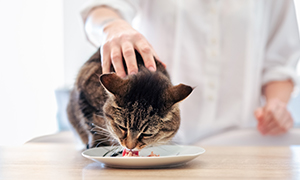EFFICACY AND SAFETY OF TWO NEW HIGH PROTEIN – LOW CARBOHYDRATE DRY DIETS IN STERILE, FELINE STRUVITE UROLITHIASIS

Introduction
Dietary dissolution is safe and effective for eradication of sterile struvite uroliths in cats. Richness in moisture and/or sodium and/or protein in order to increase water intake and thus to increase diuresis, urinary flow and the frequency of micturition may vary between commercially diets.
Materiels and methods
This prospective, multicenter, randomized, double blinded clinical trial evaluated the efficacy and safety of two new high protein-low carbohydrate dry diets (table 1) in sterile, struvite urolithiasis in cats with signs of non-obstructive FLUTD. Cats enrolled in the study were randomly assigned either to diet A,* formulated to achieve dissolution and prevention of struvite uroliths, or to diet B,** formulated to dissolve struvite uroliths. Cats were followed up to 14 days after the uroliths had been dissolved, latest to D56 ±2. Physical examination, urinalysis, and abdominal ultrasound were performed weekly (figure 1). Analyses were performed using the software SAS® version 9.4. The significance threshold was set to α=0.05 two-sided.
Results
Thirty-three cases were recruited and supplied with Diet A (n=17) or Diet B (N=16) according to the randomization procedure. Groups were comparable (table 2). The mean time of struvite dissolution was 13.1 days and 14 days respectively for diet A and Diet B (n.s). The mean time to disappearance of at least one urinary sign was 7 days for diet A and 11.4 days for diet B (p=0.03). On D7, 70.6% of cat from group A and 68.8% of cat from group B had no more urinary signs (n.s) (table 3). Mean urinary pH was decreased in groups A and B at the end of the study (6,1± 0.5 and 6± 0.6, respectively) compared to D0 (7,2 ± 0.8 and 7,2 ± 0.7, respectively). In group B, urine specific gravity significantly decreased (p=0.01) from D0 (1.046± 9.8) to the end of the study (1.036± 12.5). In group A, urine specific gravity decrease was not significant. According to owners' assessment, palatability was considered as good to very good in 88.2% and 93.6 % of cats with Diet A and B respectively. Two and 4 cats of groups A and B respectively exhibited transitory adverse events, possibly related to the diet (mild diarrhea or mild vomiting). These events resolved spontaneously and did not lead to the exclusion of any cat.
Download the complete study to see the tables of result.
Conclusion
The new high protein – low carbohydrate tested diets were effective for dissolution of feline struvite urolithiasis.

